Ballarat International Foto Biennale 2015 :: Portfolio Review
 Wednesday, September 2, 2015 at 11:29AM
Wednesday, September 2, 2015 at 11:29AM I have just done my third portfolio review in my "creative career". I am 43 and starting to question when the 'career' part of that term will start to get some traction. I decided to book 'another' portfolio review to get some guidance about where my career might be headed and what sort of opportunities there might be for my work. At this difficult time in Australia as an independent artist, I'm sure I'm not the only one questioning how I'm going to survive, and whether I should just put a cap on my creative inclinations and get on with some kind of real job.
My first review was back in 2002 in Birmingham, UK. As a younger artist this experience was pivotal in shifting my approach to my work, and provided a massive reality check. I am grateful for the critical feedback that made me realise that my figurative work would never be taken seriously in the art world - it was seen as "fashion / commercial photography" and was too technical, too aesthetic. I did not have a commercial background at the time - I went to art school and was never "technically" trained, although I was working as a photographer in the arts & entertainment industries. I decided that despite wanting to work with the human subject, I would work with objects and landscapes to explore my ideas. I have continued with this approach until now. 13 years later I realised I still had ideas that needed the human subject, and I wanted to see if I could tackle it more intelligently to create work that could sit comfortably as Art and NOT Commercial, Fashion or Portrait Photography.
So I prepared a small portfolio of new work and lugged it along to the recent portfolio reviews in Ballarat to see how this new figurative work would be received. I also prepared recent landscape work and my previous BIFB 2009 exhibition work to provide some context for reviewers not familiar with my work.
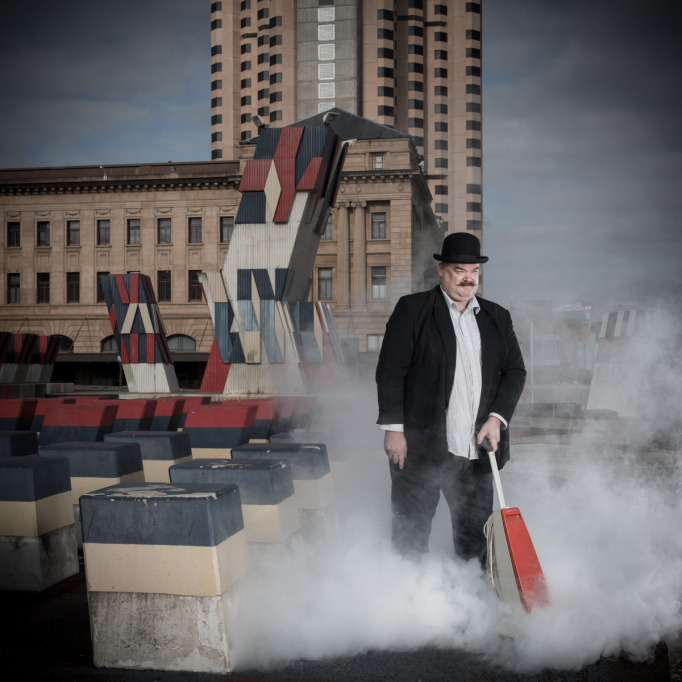
My friend Malcolm seemed an ideal subject - having looked at how other artists used the 'everyman', he reminded me of the figures in Jeffrey Smart paintings, and the figure in much of the work of local artist Christopher Orchard. The bowler hat of course also references Magritte's famous surreal work. This seemed 'safe' ground for my figure - clearly positioned in the world of the arts and NOT in fashion. Surely with Malcolm as my subject my work would bypass the fashion aesthetic and allow itself to be read conceptually? I had also just shot 2 new images the weekend before using my partner Matthew as my weatherman subject so I was interested to see how each of the characters would be seen.
The night before the review I sat down and wrote what I wanted from the review:
AIMS:
- To share new work and get feedback on the work conceptually – how is it read by the viewer?
- To gauge the reception to my work – is it interesting / relevant?
- To get feedback on any opportunities to extend the work
- Any thoughts on opportunities to show the work?
- Specific feedback on technical approach to lighting, composition, staging, palette, tone etc
Questions:
- Do the images work well together as a body of work – especially the 2 different characters within the 1 series
- Are the characters too stylized, or possibly not stylized enough?
- Square Format?
- I am hoping to exhibit the 2 characters on opposite walls in a gallery. Would this make an interesting show?
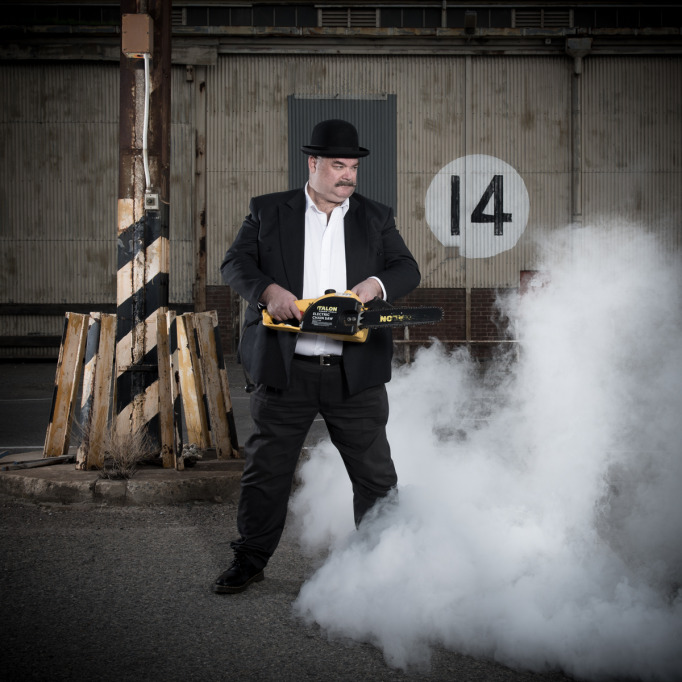
These are some of my notes and my thoughts from each of the reviews ::
The first thing she said was, "This looks like High-End fashion photography". I couldn't believe it - I almost cried. She then said that established galleries in Australia wouldn't look at work like this. "They are snobs, frankly". She also said to avoid "Ansel-Adams style" galleries. But she said it might appeal to some of the newer galleries with a younger demographic who appreciate conceptual work but recognise artists with a commercial aesthetic. It might also work for galleries in Asia but would not appeal to the European galleries.
In terms of her feedback, Crispin was probably the most helpful reviewer. She said to me that it was clear that I was obviously a commercial photographer trying to find out who I am. "This makes me interested in your work - I want to see the struggle". She suggested I stop trying to hide my technical strengths - "Your style is always going to creep in - push your strengths and externalise what is in you - but do it truthfully and boldly. Synthesise instead of dividing."
We had an interesting discussion about why I was using male subjects in my work. I talked about the fact that using female subjects would mean tackling stereotypes and I didn't want to have to do that. She suggested it would strengthen the series if I DID use a female subject, and asked what she would do to tackle the fog. Perhaps add more characters to the series or at least a third one. She said I needed to be braver, and recommended applying to arts residencies to create my work.
Of all the feedback it's the positive action suggested by Crispin that has impacted on me the most. Be brave, apply for residencies, apply to newer galleries and try Asian markets. Be honest and stop hiding my technical ability. I guess she validated my efforts to work with the figurative but to shift my attitude and not be so afraid of the inevitable "commercial" label. That's going to hard to embrace.

Kulpa responded to the images as pictures and generally liked the work. He really liked the surrealism and the quirkiness of the series, and could clearly see my interest in the work of Jeffrey Smart. His assistant mentioned that my work reminded her of the work of Toby Burrows. I can see what she means and I think I need to reflect a little on how people like Burrows use their creative work alongside their commercial work. He liked the colour and depth of the images, and found the detail interesting. He said that although I needed more images in the series, he found a visual link to my electric landscapes and said they shared the same ethereal quality and could easily be shown together. Interesting idea, as I see them as such different bodies of work.

They both loved the image of the lightbulb cloud in the landscape and responded to the sculptural form within the landscape. Kulpa suggested that the other images in the series which used randomly placed objects in the landscape would be stronger if those objects (lightbulbs) were arranged as a single form. This is something I am quite interested in anyway and I might consider that as I develop that series.
Generally Kulpa and his colleague liked the narrative element in each image and said I was definitely on the right track. I appreciated their comments but didn't find them engaged enough with the work conceptually - they didn't respond to the ideas as much as they did to the aesthetics. Perhaps that is the real critique I should take from their comments?

Poole wanted to look through the whole portfolio first, and then make his comments. After a quick flick through the work he said, "OK let's talk about the repetitive man". Wow. I'm not sure how to take THAT comment. I guess I wanted a feeling of repetition in that the fog IS persistent so there is a sense of deja-vu for the man who cannot deal with it effectively. So maybe that's a compliment to the concept. But I doubt it. I think it's best to take that as a criticism in that there is not enough variation in the series.
He went on to say that they are very uniform "because the lighting technique doesn't change, it's too formulaic." He suggested to use 1 light and a reflector rather than 2 lights and proceeded to give me a lighting lesson. I don't think I looked too impressed. I guess I felt that I wanted critique rather than a lesson in lighting and as a photography lecturer (he wasn't to know that) I already understand the Inverse Square Law and didn't need the precious 20 mins wasted on that. But I guess it WAS useful when he said "the story changes when you change the lighting" - I hadn't seen the lighting as a feature of the work. More of a means to an end. But Poole spent most of our time talking about the lighting so I guess he genuinely saw an issue with it. He suggested one giant octabox ("the biggest you can get your hands on") for more contrast. He also said to be careful with my range of backgrounds - there are 2 images with roller doors which is a problem. He's right.
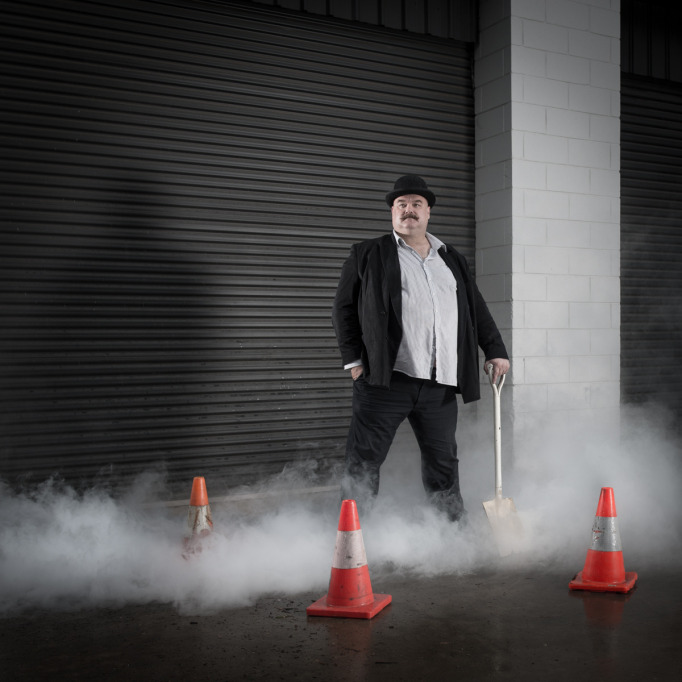
In response to my other work he basically said that he prefers my earlier work (the Short Circuit series) - he said it's stronger and more emotional, delicate and intimate. He was talking about the B&W typologies. Interesting to use those words with objects that are treated so objectively. He finished off with a protest against why I'd allowed myself to photograph one of the objects in such harsh sunlight. I guess he had his lighting hat on that day, and that's what he most wanted to discuss. I didn't find his comments productive but I do appreciate his candour and of all the reviewers he was definitely the least enamoured with my work!
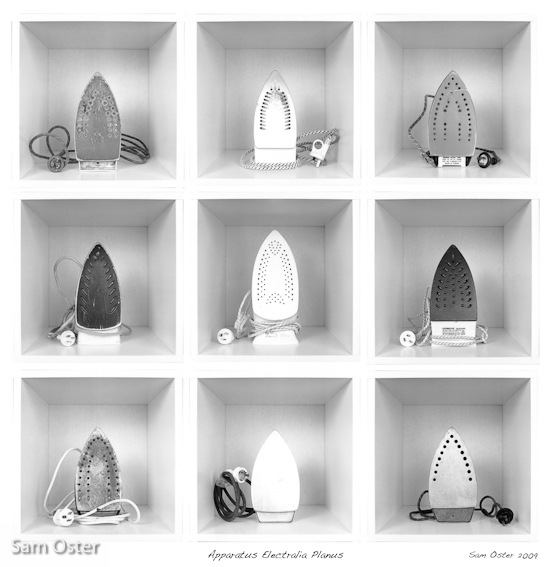
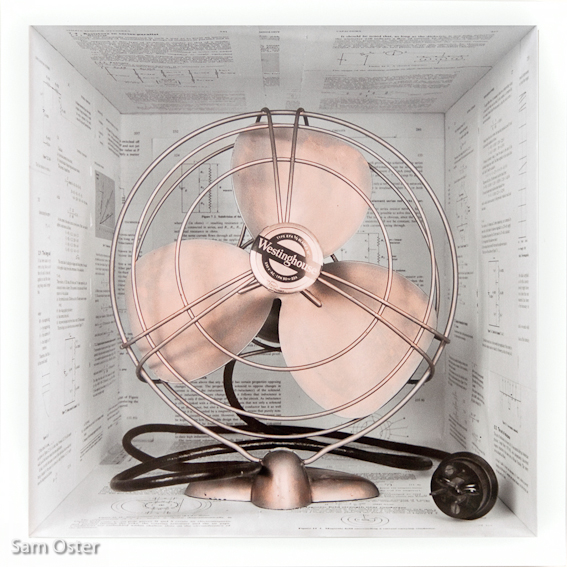
I was very excited to meet Sally as we had had a few chats over the phone about meeting up for a formal session at some stage and I was hoping to bring her to Adelaide for some kind of mini review event at some stage. She was interesting and took a different approach to her feedback. She nitpicked specific details in the work and suggested edits - this was actually pretty handy from a refinement point of view, but not what I had expected. For example she suggested that I change the colour of the Hoover to match the red in the landscape on one of the fog series - I think this is a good idea - I don't tend to even think about post-production changes to my work (which is primarily captured in-camera and simply tweaked with de-saturation and a vignette). She suggested I get rid of the umbrella in one of the weather balloon shot as it was too obvious and a bit distracting. I agree. She also noticed a distracting twig in the foreground.
She said she really liked the humour in the work but suggested I keep it simple. Overall she said I needed to be careful about over-doing a theme and that just 2 or 3 images in a series is OK. There's not enough variation in what the character is doing to sustain a larger series. "Go for just 3 shots of the Big Man - otherwise he is just doing a similar thing in a different location. But I want to see more of the Goggle Man." She was impressed with the quality of my presentation and said I had "nailed" my marketability with slick and careful presentation. She said it was obvious that I was a commercial photographer.
It was great to get the feedback to simplify the series but add variation. I think it echoes what Ian Poole was saying but where he took issues with repetition in the technique I think Sally articulated the real issue - there is too much repetition in the concept. If I throw in what Judith Crispin suggested, I think I now know what I need to do in this series - perhaps add a third character with a different approach to the fog, and use more variation in how I stage each image. Sally's closing remarks were that as an art-based photographer whatever I do needs to come from the heart.
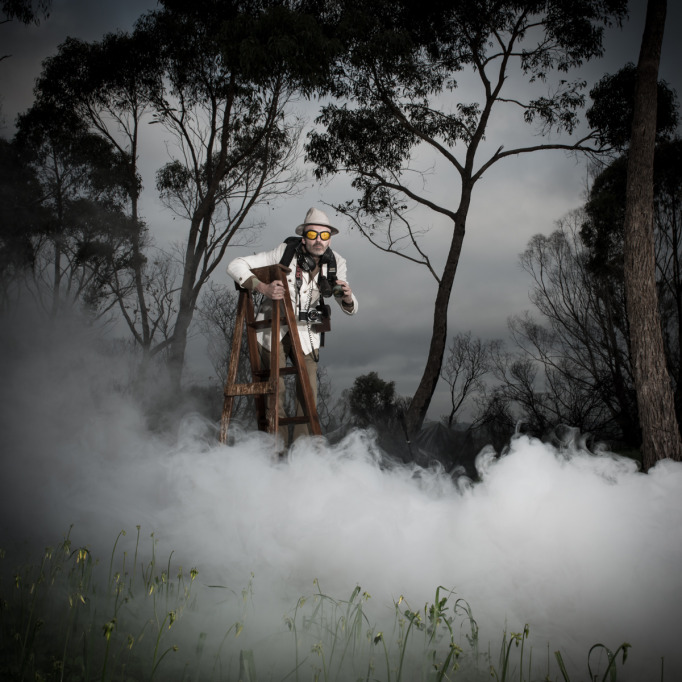
Foster said first-up that my work was well made in terms of how I get the images on the paper. I think he means that it is technically well done? He went on to say that these days viewers respond well to properly crafted images. "Commercially 'solid' work brings respect, and viewers are then more likely to spend time with the image and consider the concept." Yay, it was really nice to hear that. I hope it's true. BUT then he hit me with some proper criticism: "The problem is in your directing of the subject. Your subject is not really properly engaged in the action of the image". If he is meant to be sweeping then he should be sweeping. I did actually shoot lots of variation in the action but for some reason most of my selections have gone with the more passive action - the moments between the action. I thought this would emphasise the pathos of the approach. But Foster suggested that the humour within the series would be better expressed if I took a more 'physical theatre' approach. He said that I should perhaps work with physical theatre actors and look seriously at the films from the silent movie era - characters like Charlie Chaplin, and Laurel and Hardy. Kulpa had also mentioned the visual link to these sorts of characters.
I can't remember what I said but Foster then said that I should "let go of the fear of judgement and make the work you want to make. Don't second-guess critique or you will grind to a halt." Perhaps I expressed my fear of the images being seen as portraits of characters rather than of concepts.

Foster was more interested in my electric landscape series. He loved the lightbulb cloud (like Kulpa) and also commented that it looked like an organic object. "It has an irony that engages the mind as well as being aesthetically pleasing." He really liked that it looked like the object had been washed up from the sea, and that it had a cyclic relationship that inevitably threw up the question of cause and effect. In the same way he really liked the image of the fluorescent tubes "aspiring to be what the stars are". He liked that these 2 images in the series had anthropomorphic qualities that also engaged ethical issues. The others in the series seemed just a placement of objects and didn't have the same resonance with the landscape. I really need to think about that and I feel that will impact on how I make choices as I progress with that series. Interestingly, Sally Brownbill and most of the other reviewers (I think) really didn't like the image above and suggested I should remove it from the series. I guess there will always be wild variation in the subjective views of reviewers and that ultimately as artists we just have to be instinctive - there will always be variation in how people see the work.
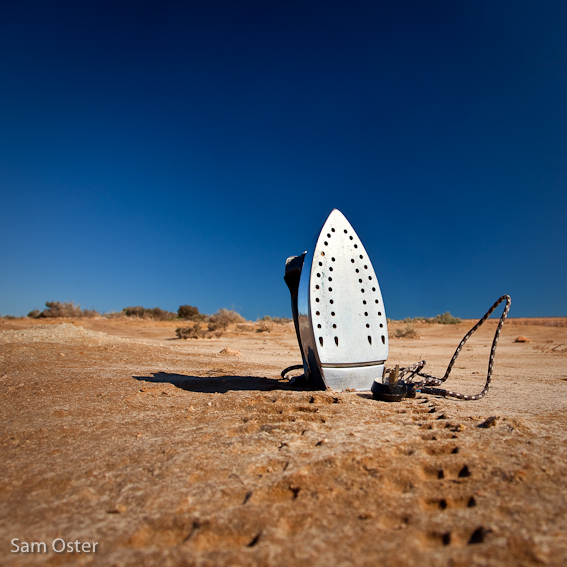

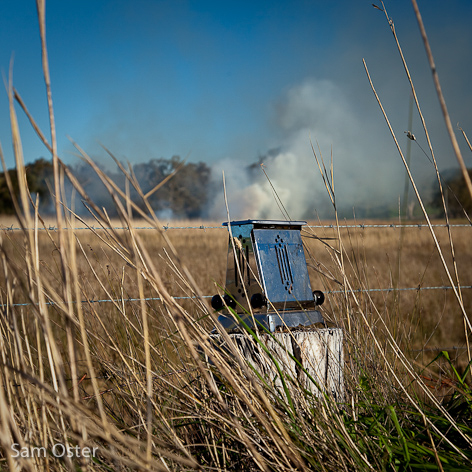
Alasdair Foster said my work with the objects reminded him a little of the work of UK artist Sian Bonnell. I am familiar with her work and it turns out he is working with her on presenting her work in Europe (?) soon. He called her work "absurdist". He liked the monumental form of the iron and liked that it looked like a building or the sail of a boat. He also commented on the way the objects in the landscape "aspire to achieve the action of natural forces - like the fan aspires to the action of the wind". He actually got the work, which was really nice.
However, he said that my typology work is less innovative than my recent work and that it would struggle to compete in a busy environment where there was already "lots of this kind of work."
In summary, Foster said that my recent work was a little more unique and that I just needed to tighten the conceptual framework. "Think of your objects as performers." He recommended that I look at how Shakespeare uses humour to highlight serious topics, and to look ways that theatre uses irony to draw the mind in. He echoed what the other reviwers has said by suggesting that I could only "sustain a series if there were enough differences to add depth." He recommended that I attend other photography festivals Internationally, and show my work at some of the smaller festivals around the world.
IN SUMMARY
I found the review experience very useful, as always. What it didn't do was offer a magic answer to how I can survive as an artist. It didn't mean that I went away with all the answers. But it did offer me a very good idea about how to develop the new work to strengthen it (more variety in style and content within the same framework) and I am more confident now to tackle these suggestions:
1) Keep shooting both new series with the above feedback in mind (All reviewers);
2) Edit and tweak my existing work (Brownbill) and reduce some parts of the series while extending others (Crispin, Brownbill);
2) Apply for arts residencies (Crispin);
3) Apply to newer galleries in Asia and places like 'Magnet' in Melbourne (Crispin);
4) Attend overseas festivals and show my work there (Foster);
5) Don't be so afraid to be myself as an artist - be braver and less worried about critcism and stop trying to hide my technical ability and commercial aesthetic.
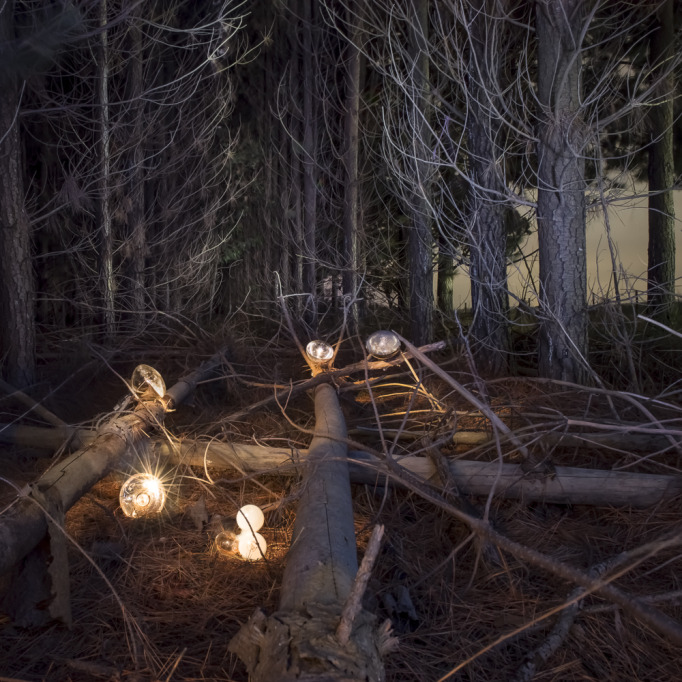
Reader Comments (2)
Great blog post Sam - really interesting feedback from all of the reviewers! Just wanted to pop by and say if you ever need a female to pose and 'challenge stereotypes' I'm willing and able!!
Sam,
given your circumstances as a commercial photographer you shouldn't have to apologize for this or deny it. How can you deny it ? It's who you are. What is of interest are the projects and what they say to us as viewers as projects --not the individual images.
Given your lack of confidence as an art photographer and a female one, why doesn't your figurative project express this lack of confidence. That would mean using a female model in a public space, but developing the ideas around those ideas would push you beyond the repetition of the everyman.